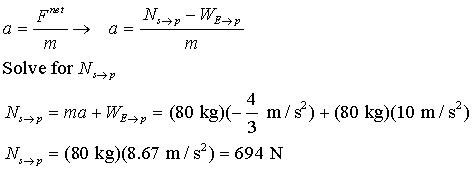PHYSICS 121 - LANGENBERG
HOMEWORK 5
SOLUTIONS
1. Al and George pushing the truck
(a) Here's the free-body diagrams for the car and the truck.
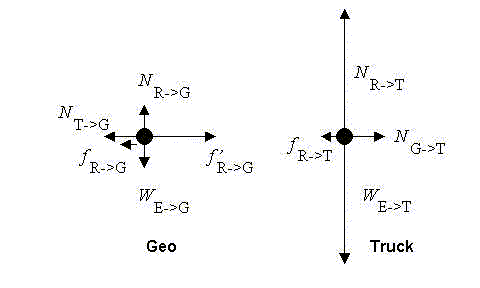
Both the truck and the Geo are accelerating. Therefore, the net horizontal force
on each must be in the direction of the acceleration. If we ignore the air resistance
and frictional effects of the non-driven tires not rolling perfectly, the forces
must be ordered as follows:
f'R->G > NT->G = NG->T
> fR->T > fR->G
That is, the friction force of the road on the Geo pushing it forward (and arising
from the Geo's engine turning the tires so their friction is trying to push
the road backwards) must be greater than the normal force the Geo feels pushing
back on it from the truck (in order for it to accelerate forward). The normal
force the truck exerts on the Geo and the Geo exerts on the truck must be equal
by Newton's third law. For the friction pointing backwards, the friction felt
by the truck must be less than the normal force pushing it forward. For the
Geo, the friction force plus the push of the truck backwards should be less
than the push of the road forwards (f').
(b) If the vehicles are accelerating uniformly for 5 minutes, start from an
initial velocity of zero and end up at a velocity of 20 miles/hour, the average
velocity is 10 miles/hour. So we can calculate the distance from

(c) Recall that when objects have an applied force but are not moving, the static
friction force adjusts itself to counter the applied force (if it can), not
to take its maximum value. Since the truck is not moving, the net force on it
is 0 and the friction force between it and the road must be 1000 N backwards.
Let's check to make sure this is possible. The normal force squeezing the truck's
tires and the road together is in this case equal to the truck's weight, mg
= (4000 kg)(10 N/kg) = 40,000 N. The maximum friction force is 0.1 times that
or 4000 N. Clearly the car has to exert a bigger force.
2. Pushing a carriage
We can begin in a number of different ways. The most straightforward is to start
with the velocity graph, since that is the one we have the most direct information
about. It says at time t = 0 the carriage is moving with a constant velocity
so on the velocity graph we draw a straight horizontal line. When she releases
the carriage it slows and comes to a stop. We don't actually know how it does
this, but if the only force acting on it is kinetic (moving) friction, that
is likely to be a constant so, by N2, the acceleration should be constant. This
would make the velocity a straight line angled downward on the velocity graph
until it reaches 0 at time t2. This is the graph shown in the second picture
below.
The position graph is easy to draw from this. When the velocity is constant,
the position is changing at a constant rate. When the velocity is decreasing
but positive, the position continues to increase, but curves over. This is shown
in the first graph below.
The acceleration is easily inferred from the velocity graph. While the velocity
is constant the acceleration is 0. While the velocity is decreasing at a uniform
rate, the acceleration is constant negative. This is shown in the third graph
below.
Since, by N2, the acceleration and the net force are proportional, the net force
graph should look the same as the acceleration graph. The net force is made
up of two parts: the friction, which is a constant negative force, and her push,
which is positive. We easily draw the friction graph. We construct the graph
of her push so that when it is added to the friction we get the net force graph,
which we already know.
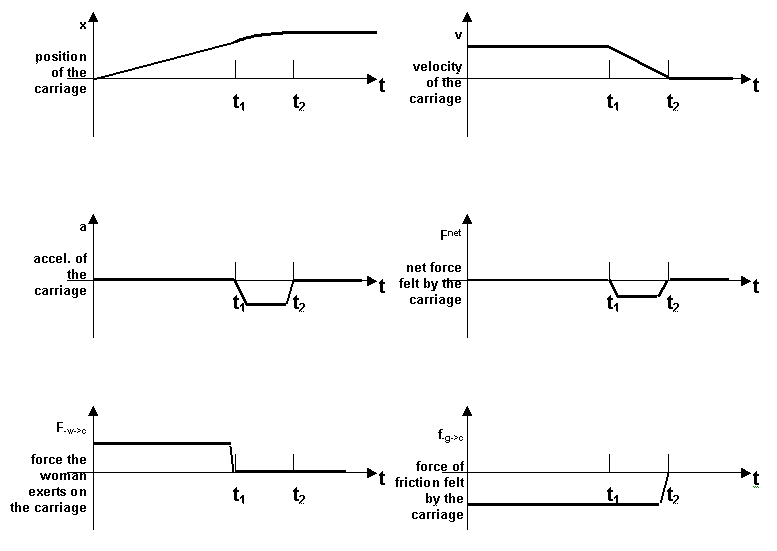
3. Pushing a box
Let's do these in a natural order.
The problem describes the force exerted by the worker. First it is a large force,
then a smaller one, both positive. Finally, the force has to be negative. If
we take the forces exerted in each region to be constant, we get that item (b),
the force exerted by the worker could be graph E. Friction doesn't depend on
speed so once the cart gets moving it should be constant and trying to keep
the cart from moving, therefore negative in this example. Therefore, the force
of friction, item (a) could be graph A.
The net force in this case is the sum of the horizontal force exerted by the
worker and the friction. The vertical forces on the cart (gravity and normal
force from the floor) cancel since the cart has no vertical acceleration. The
sum of graphs A and C could be E, so this is what we choose for item (c).
Since a=Fnet/m and m is constant, the graph for the acceleration of the cart
and the net force it feels should have the same shape. Therefore, we choose
for item (d) the graph E as well.
The last one to do is item (e), the velocity. We can get this by looking at
the acceleration. Since it is experiencing constant acceleration in the first
time segment, the velocity will increase linearly. In the second time segment
the acceleration is 0 so the velocity should be constant. In the third time
segment, the acceleration is constant negative so the velocity must drop linearly.
Graph B does this.
Graph D represents the position, which was not asked for here.
4. The bridge at Mostar
(a) A falling object only feels the force of the earth pulling on it, it's
weight. Therefore, its acceleration will be downward and its magnitude will
be given by
a = Fnet/m = W/m = mg/m =
g
The key equations are
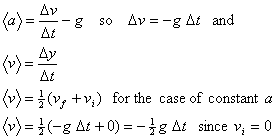
Using the last equation in the first , we get
Δy = -½ g (Δt)2
Putting in Δy = -23 m and solving for Δt gives

(b) After falling for a time Dt at an acceleration a, his change in speed would
be
Δt = a Δt
vf = vi + a Δt
vf = 0 + (9.8 m/s2) (2.17 s) = (9.8) (2.17) m/s = 21.3 m/s
(c) It takes the diver 2.17 s to hit the water. The sound must then travel 23
m back up to the spectator. Sound travels at 340 m/s (gravity doesn't affect
it), so it will take a travel time we can get from the equation

We know the speed of the sound and the distance, so we want to solve for the
time:

The total time is therefore 2.17 s + 0.07 s = 2.24 s.
5. Riding an elevator
(a) Since the passenger is not accelerating, the two forces acting on him must
be equal and opposite by N1. That is, the passenger's weight equals the upward
(normal) force from the scale: Nscale->passenger = - Wearth->passenger.
By N3, any pair of forces with their labels reversed -- two forces objects exert
reciprocally on each other -- must be equal and opposite. Therefore Nscale->passenger
= Npassenger -> scale. The sum of the two downward forces on the scale is
also equal to the upward force on the scale, but that wasn't asked for.
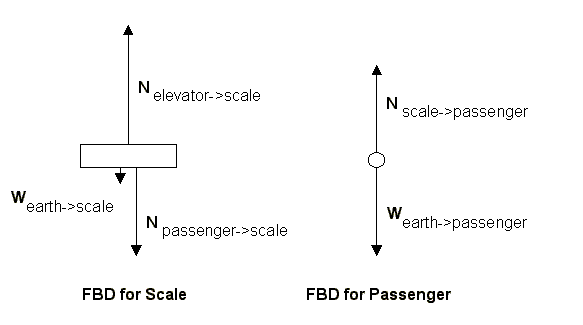
(b) The only forces in the diagram that can change are the normal forces. We
know that the weights don't change, no matter how an object moves (unless it
moves far from the earth's surface). If the elevator is accelerating downward,
it is trying to move away from the scale. So the normal force the elevator exerts
on the scale will be reduced. Since the scale is trying to move away from the
passenger, the normal forces between the two of them will also be reduced.
(c) When an object is accelerating, we can't apply N1 but N3 always applies
no matter how the objects are moving. Therefore, now only the normal forces
of the scale on the passenger and the passenger on the scale will still be equal.
(d) The scale reads whatever normal force it is exerting since that tells how
much its spring is being squeezed. Therefore the value will be Nscale->passenger
= Npassenger -> scale. The latter is the easiest to calculate from a = Fnet/m.
Since we know the motion of the passenger (assuming he stays on the scale),
we should be able to get a. We also know m and one of the forces (the passenger's
weight). There should therefore be only one unknown in our equation and we should
be able to solve for it. Let's start by finding a.

Now we can figure out the normal force.
